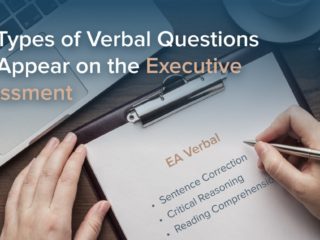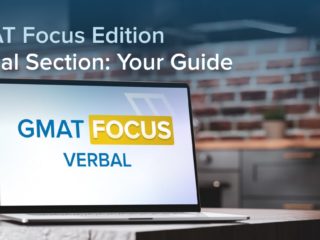Last Updated on October 2, 2023
If you’re considering taking the GMAT to apply to business school, you’re likely aware that the GMAT has four sections, one of which is the Verbal Reasoning section. So, you may be wondering what exactly to expect from the Verbal Reasoning section of the GMAT and how to prepare for it. In this post, I’ll discuss the three main GMAT verbal question types and a bit about how to master each of those types of questions to hit your GMAT verbal score goal. First, however, let’s discuss the basics of the GMAT’s Verbal Section.
- The Basics of the Verbal Section of the GMAT
- GMAT Verbal Question Types
The Basics of the Verbal Section of the GMAT
According to the website of the Graduate Management Admission Council (GMAC), “The Verbal Reasoning section of the GMAT exam measures your ability to read and comprehend written material, reason and evaluate arguments, and correct material to express ideas effectively in standard written English.” Simply put, the Verbal section of the GMAT is a test of skill in understanding what you read, noticing issues and other details, and using logic to arrive at correct answers.
The Verbal section of the GMAT tests those skills by presenting 36 multiple choice questions that a test-taker has 65 minutes to answer, or about 1:48 per question. Those 36 verbal questions on the GMAT include questions of three types: Sentence Correction, Critical Reasoning, and Reading Comprehension.
OK, now that we have a basic understanding of the GMAT Verbal section, let’s discuss each of the types of verbal questions that appear on it, starting with Sentence Correction questions.
GMAT Verbal Question Types
Sentence Correction Questions
Of the 36 questions that appear on the Verbal section of the GMAT, 12 to 13 are Sentence Correction questions. The format of GMAT Sentence Correction questions is the following.
Each Sentence Correction question presents us with a sentence, and all or part of the sentence is underlined. Below that sentence are five answer choices, which present five ways of phrasing the underlined portion of the original sentence.
The first answer choice, answer choice (A), offers phrasing that is a repeat of the underlined portion of the original sentence. In other words, whatever words and punctuation are underlined in the original sentence will be the words and punctuation that are presented in answer choice (A). Each of the other four choices presents an alternative way of wording the underlined portion of the sentence.
Our task in answering a Sentence Correction question is to select the answer choice that offers wording that produces the best version of the sentence.
KEY FACT:
Our task in answering a Sentence Correction question is to select the answer choice that offers wording that produces the best version of the sentence
To see how GMAT Sentence Correction questions work, let’s consider an example:
Sentence Correction Example
Carl Jung’s research were the basis of analytical psychology to profoundly affect scholars in other fields, including Joseph Campbell.
- were the basis of analytical psychology to profoundly affect
- was the basis of analytical psychology and has profoundly affected
- have been the basis of analytical psychology profoundly affecting
- were the basis of analytical psychology and were a profound effect on
- is the basis of analytical psychology to be a profound effect on
Solution:
As we just discussed, our task in answering this question is to select the answer choice that offers wording that produces the best version of the sentence. So, to find the correct answer, we go through the choices, eliminating ones that are clearly incorrect and choosing the one that produces the best version of the sentence.
In this case, eliminating choices (A), (C), and (D) is relatively straightforward since the plural verbs “were” and “have” in those choices don’t agree with the singular subject of the sentence, “Carl Jung’s research.” So, we’re left choosing between (B) and (E), which have the singular verbs “was” and “is,” which agree with “research.” Then, reading choice (E), we see that it says something that doesn’t make sense, which is that “Carl Jung’s research is the basis of analytical psychology to be a profound effect ….” Since “research” would not “be a profound effect,” choice (E) can’t be the correct answer. Thus, choice (B) is the best answer since the sentence produced by choice (B) makes sense.
Now that we know the format of GMAT Sentence Correction questions and have a basic sense of how to go about answering them, let’s discuss some key tips for mastering GMAT Sentence Correction.
Tips for Mastering GMAT Sentence Correction
Meaning matters. – As we saw in answering the above example question, answering a Sentence Correction question often requires noticing issues involving meaning conveyed. So, while knowing basic grammar rules is certainly an important aspect of Sentence Correction mastery, in order to get Sentence Correction questions correct consistently, we have to develop skill in determining what a sentence conveys and whether that makes sense.
Look for the best choice, not the perfect choice. – Often, the correct answer to a Sentence Correction question will produce an OK, but not ideal, way of expressing a meaning. So, to consistently get Sentence Correction questions correct, we must look for the choice that produces the best sentence version, rather than seek a choice that produces a perfect version.
Practice Sentence Correction by doing careful analysis of sentence versions. – The most effective way to practice Sentence Correction is to take your time, learning to see the issues in the various sentence versions and articulate what they are. Then, once you’ve developed skill in analyzing the sentence versions, you can seek to speed up to the pace you’ll have to keep to complete the Verbal section of the GMAT on time.
TTP PRO TIP:
To master GMAT Sentence Correction, keep in mind that meaning matters, look for the best choice, not the perfect choice, and practice Sentence Correction by doing careful analysis of sentence versions.
Now that we have a basic understanding of Sentence Correction questions and some ideas regarding how to master Sentence Correction, let’s move on to the next type of GMAT Verbal question, Critical Reasoning questions.
Critical Reasoning Questions
Of the 36 questions that appear on the Verbal section of the GMAT, 9 to 10 are Critical Reasoning questions. The format of GMAT Critical Reasoning questions is the following.
Each Critical Reasoning question begins with a written stimulus, which is usually, though not always, in the form of a short passage of about 100 words or fewer. Along with the stimulus is a question and five answer choices. The question will always ask us to determine which of the five answer choices is logically related to the stimulus in a particular way.
Of course, the correct answer to a Critical Reasoning question will be the choice that matches what the question asks us to find.
KEY FACT:
The correct answer to a Critical Reasoning question will be the choice that matches what the question asks us to find.
To see how GMAT Critical Reasoning questions work, let’s consider an example:
Critical Reasoning Example
Recently, sales of figs have dramatically increased in many areas of the country. Just before the increases in sales of figs began to occur, a new video game was released in which characters become powerful by eating figs. Clearly, the reason for the increases in sales of figs is people’s seeing figs portrayed as sources of power in the new video game.
Which of the following if true provides the most additional support for the conclusion of the argument?
- Because fig trees can thrive in a range of climates, it is possible to grow figs in many areas of the country.
- Sales of blueberries also have increased recently.
- Not only sales of fresh figs but also sales of dried figs have increased recently.
- Sales of figs have increased only in areas of the country in which the new video game is popular.
- Figs are sources of important nutrients and of antioxidants.
Solution:
To answer this Critical Reasoning question, we have to first carefully read the passage to understand the argument it presents. Then, we read the question stem to find out what kind of answer choice to look for, and finally we choose the choice that matches what the question asks us to find.
In this case, the correct answer will provide additional support for the conclusion of the argument presented by the passage. The conclusion of the argument is “the reason for the increases in sales of figs is people’s seeing figs portrayed as sources of power in the new video game.” So, the correct answer is choice (D). After all, the fact that “sales of figs have increased only in areas of the country in which the new video game is popular,” tends to confirm the argument’s conclusion by making a connection between the video game and sales of figs.
Now that we know the format of GMAT Critical Reasoning questions and have a basic sense of how to go about answering them, let’s discuss some key tips for mastering Critical Reasoning.
Tips for Mastering GMAT Critical Reasoning
Critical Reasoning is not a word matching game. – It’s easy to get the impression that the path to finding the correct answer to a Critical Reasoning question is to look for a choice that seems to match what the passage says. However, the truth is that the correct answer to a Critical Reasoning question often brings up something not mentioned in the passage. So, the only sure path to the correct answer to a Critical Reasoning question is to use logic to determine which choice actually answers the question asked by the question stem.
When practicing Critical Reasoning, analyze every answer choice. – For best results, when you’re answering Critical Reasoning practice questions, stick with each question until you understand why every choice is correct or incorrect.
Learn Critical Reasoning one question type at a time. – There are 11 types of Critical Reasoning questions that appear on the GMAT. For best results, focus on one type of Critical Reasoning question at a time, becoming skilled in answering one type before you move on to the next one.
TTP PRO TIP:
To master GMAT Critical Reasoning, keep in mind that Critical Reasoning is not a word matching game, analyze every answer choice of each practice question you answer, and learn Critical Reasoning one question type at a time.
Now that we have a basic understanding of Critical Reasoning questions and some ideas regarding how to master Critical Reasoning, let’s move on to discussing the final type of verbal questions that appear on the GMAT, Reading Comprehension questions.
Reading Comprehension Questions
Of the 36 questions that appear on the Verbal section of the GMAT, 13 to 14 are Reading Comprehension questions. The format of GMAT Reading Comprehension questions is the following.
The GMAT presents a passage of between around 220 to 480 words. Along with the passage, three or four questions about the passage are presented one at a time. Each question has a question stem and five answer choices.
Our task in answering each GMAT Reading Comprehension question is to select the answer choice that is supported by what the passage says.
KEY FACT:
Our task in answering each GMAT Reading Comprehension question is to select the answer choice that is supported by what the passage says.
To see how GMAT Reading Comprehension questions work, let’s consider an example:
Reading Comprehension Example
In the early 20th century, Leslie County, Kentucky had very few physicians and poor roads, and thus it was extremely difficult for people living there to access medical care. To address this issue, Mary Breckenridge, a certified nurse midwife, founded in 1925 the Frontier Nursing Service (FNS), which employed nurse midwives and grew to include several clinics. While nurse midwives were not licensed to prescribe medicine, the FNS worked with an advisory group of physicians who set up guidelines for the nurses to follow in situations in which a physician was not present. Under this framework, the nurses were able to legally provide treatment and medication to patients who would not otherwise have received them, with the result that, according to multiple measures, average health outcomes in Leslie County were better than those in the U.S. as a whole.
The success of the FNS is just one example of what can be achieved when nurses are able to work to the full extent of their training. Nevertheless, in the current regulatory environment, nurses are restricted from providing many of the types of services that the nurses of the FNS provided. Meanwhile, in many ways, the current strains on the healthcare system resemble the reasons why the FNS was created. Therefore, a review and adjustment of regulations that constrain nursing should be undertaken to make it possible for nurses to play a greater role in healthcare and meet needs that are currently going unmet.
The passage suggests that which of the following was true of the Frontier Nursing Service?
- Its nurses were licensed to provide medication to patients.
- It was the first nursing service founded in the U.S.
- Its nurses knew more about medication than most physicians.
- Its nurses were successful because they enjoyed their work.
- Its activities in Leslie County were beneficial to the health of people who lived there.
Solution:
To answer this question, we first read the passage. Then, we read the question, and finally we find the answer choice that states what the passage suggests was true of the Frontier Nursing Service.
In going through the choices, we see that only one choice is supported by what the passage says, choice (E). After all, the last sentence of the first paragraph of the passage says that the “result” of the activities of the FNS was that “average health outcomes in Leslie County were better than those in the U.S. as a whole.”
Now that we know the format of Reading Comprehension questions and have a basic sense of how to go about answering them, let’s discuss some key tips for Reading Comprehension mastery.
Tips for Mastering GMAT Reading Comprehension
Read for understanding. – Reading Comprehension questions indeed test our comprehension of what passages say. Thus, a key aspect of getting Reading Comprehension questions correct is understanding what we read. So, don’t fall for gimmicky strategies that involve reading only certain parts of passages or focusing only on certain words. Instead, seek to understand what Reading Comprehension passages say.
Return to the passage as necessary. – When answering Reading Comprehension questions, for best results, return to the passage to determine whether choices you’re considering are supported by what the passage says. Remember, the information needed for answering a Reading Comprehension question is right there in the passage. So, use that information.
Beware of trap answer choices – Reading Comprehension questions often include trap answer choices written to appear to match what the passage says. For best results carefully determine whether a choice you’re considering is actually supported by the passage or is written to sound like the passage but isn’t supported by what the passage says.
TTP PRO TIP:
To master GMAT Reading Comprehension, read for understanding, return to the passage as necessary when answering questions, and beware of trap answer choices.
Now that you know the types of GMAT questions that appear on the Verbal section, you’re ready to start mastering them. For a deep understanding of how to prepare for GMAT Verbal see these posts on how to score high on GMAT Verbal and how to maximize the results you get from your GMAT verbal practice.



